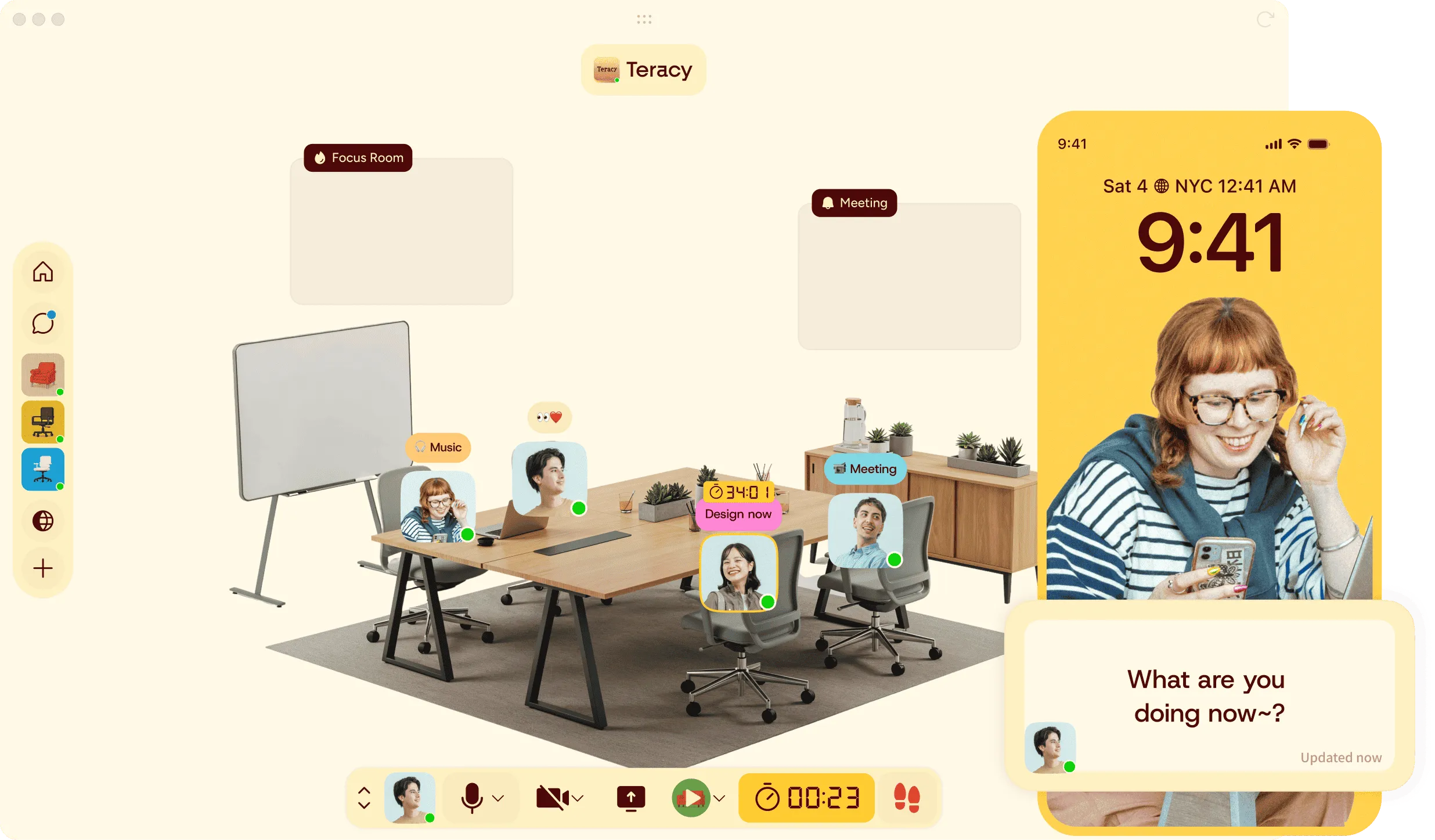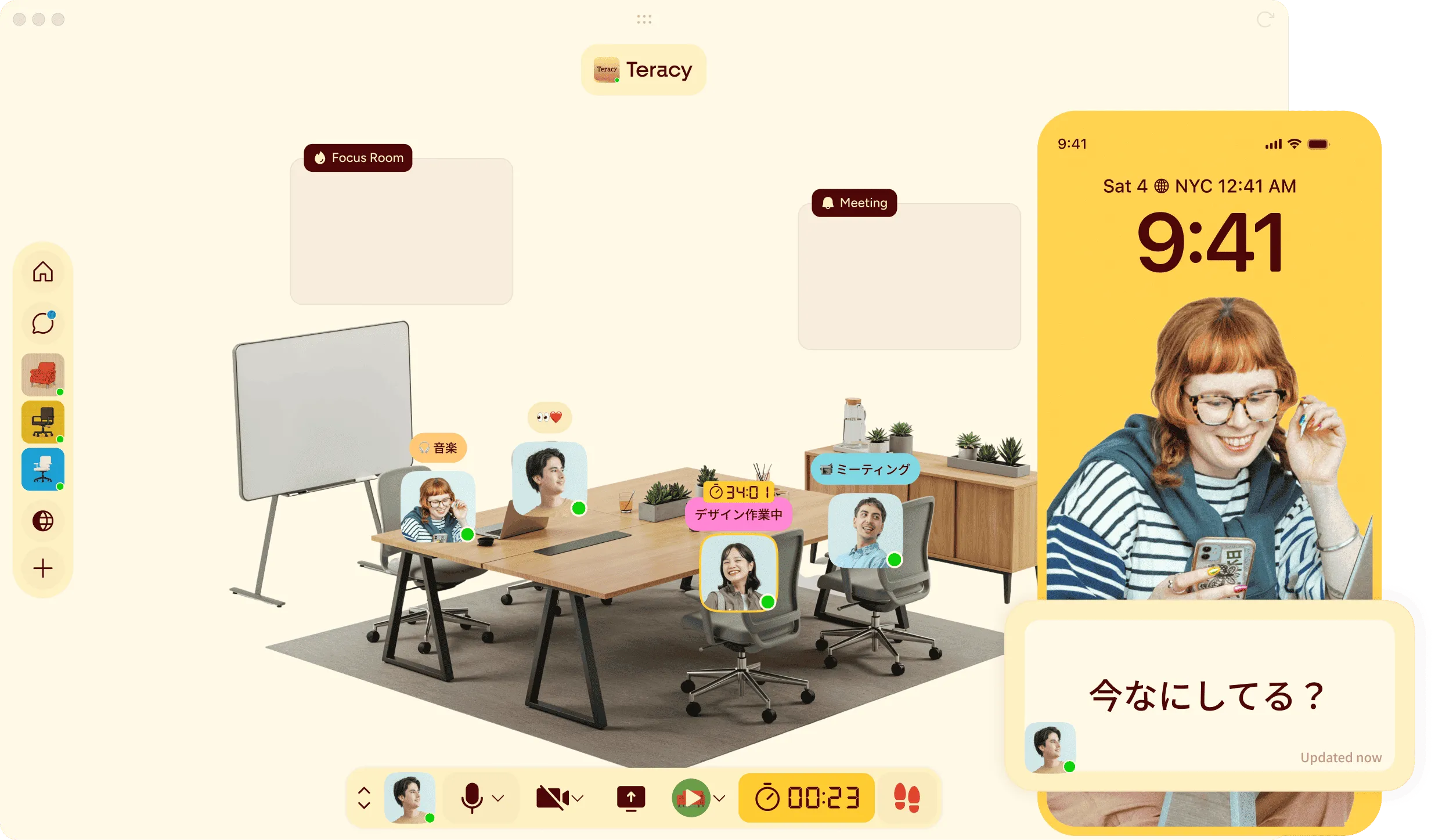Story
[Why I Joined Teracy] 「タスク」は解決したが、「つながり」を失った ─ 私がTeracyにたどり着くまでの道のり
SHARE THIS POST
My path to the Teracy project team did not involve recruiters or job boards; it hinged on a stubborn question:
Teracyのプロジェクトチームにたどり着くまでの道のりは、
リクルーターや求人サイトとは無縁でした。
そのきっかけはひとつの執拗な問いだった。
"How could remote collaboration feel as natural as sharing a desk with a teammate?"
それは、「リモートでも、隣で机を並べて働くのと同じ自然さを再現できるだろうか。」というものだった。
At my previous company I joined the early planning for a project with the same goal.
前職で、同じ課題に取り組むプロジェクトの立ち上げ段階に参加しました。
I focused on the technical and UX questions that might move remote collaboration beyond scheduled calls toward a shared-table rhythm.
私が注力したのは、リモートでの連携を、単なる「予定された通話」から「同じテーブルを囲むような自然なリズム」へと昇華させるための、技術的およびUX上の問いでした。
The outcome never matched that ambition, and the gap stuck with me.
しかし、結果としてその高い目標には届かず、
その時の未達成感がずっと残り続けていたのです。
I wasn’t interested in making an existing workflow ten percent more efficient.
既存のワークフローを単に10%効率化するようなことに対しては全く興味がありませんでした。
I kept experimenting with new interactions and lightweight protocols to see whether any combination could restore the ambient sense of co-presence teams rely on.
どの組み合わせなら、チームが頼りにしている
「その場にいるような空気感や共存感」を取り戻せるのか。
それを確かめるために、私は新しいインタラクションや軽量プロトコルの実験を続けました。
I wanted to move beyond the classic boxed-in window paradigms that most applications offered, so I pushed prototypes that layered presence cues outside that frame.
ほとんどのアプリケーションが提供する、
従来の「ウィンドウ型」というパラダイムから脱却したかったのです。
そのために、あえて「フレームの外側」に人の存在感を示すヒントを
レイヤー化するというプロトタイプを進めました。
The tools I tried still felt transactional—they solved tasks, not relationships.
しかし、試したツールは、
どれもまだ「業務処理的」なものに感じられました。
それらはタスクは解決しても、人間関係は解決してくれなかったのです。
So when that project wrapped and I shifted to a different team, the original problem statement stayed with me. It felt like unfinished work about the future of how we collaborate, and I didn’t want to let it fade.
プロジェクトが終わって別チームへ移ったあとも、この問題は頭から離れませんでした。
これは「これからの協働のあり方」という未来に関する「やり残した課題」のように感じられ、
その問題に対しての意識を手放すことができませんでした。
In my personal time I kept digging into remote communication systems, real-time data flow, WebRTC, Electron, and how fresh UI patterns could layer with proven UX foundations
そしてプライベートの時間を使っても探求を続け、リモートコミュニケーションシステム、リアルタイムのデータフロー、WebRTC、Electron、そして『新しいUIパターン』を『確立されているUXの基盤』とどう組み合わせるか、といったことを掘り下げていました。
—searching for approaches or peers who saw the gap the same way.
私は同じようにそのギャップを認識している仲間やアプローチの方法を探していたのです。

Chiharu and Ludy
One night, while reviewing how other teams tackled similar problems, I landed on the Teracy team’s homepage.
ある夜、他のチームが同様の問題にどう取り組んでいるかを調べていたところ、Teracyチームのホームページにたどり着きました。
What I read there felt like a continuation of the experiments I had been running alone. Their language around craft, presence, and human-scale collaboration matched the memos I had been recording in my notebook.
そこに書かれていたことは、まるで私が一人で続けてきた実験の「続き」であるかのように感じられました。
「ものづくりへのこだわり」や「人の気配」、そして「人間味のあるやり取り」。
彼らが使うそれらの言葉は、私自身が手帳に書き留めてきたものと、驚くほど一致していたのです。
After digging through their homepage, it was clear that few teams were tackling the problem with that level of depth.
彼らのホームページを深く掘り下げて読んでみると、この問題に対してあれほどの解像度で取り組んでいるチームは、他にまったくいないことがはっきりと分かりました。
Reaching out felt like the next sensible step so we could compare technical and UX approaches and see how their assumptions lined up with mine.
だからこそ、彼らに連絡を取ることは、ごく自然で合理的な次の一手だと感じました。
そうすれば、お互いの技術面やUXのアプローチを比較検討し、彼らの問題に対する前提が私の前提とどれほど一致するかを確かめられると思ったのです。
When we finally talked, it confirmed that they saw remote work as only one part of the larger problem. They were focused on restoring the informal layer that lives outside scheduled meetings and message threads;
ついに彼らと話した時、リモートワークを「大きな問題の一部」としてしか捉えていないということがわかった。
彼らが本当に取り戻したかったのは、予定された会議やチャットのスレッドといった『かしこまったやり取り』の外側に存在する、あの『何気ないつながりが生まれる空気』そのものでした。
the quick questions, shared focus, and incidental visual or auditory cues that keep distributed teams connected.
例えば、誰かに気軽に「ちょっといいですか?」と声をかけられる雰囲気。 言葉を交わさなくても、同じ作業に没頭しているという「一体感」。 そして、離れた場所でもチームの「気配」を感じられる、ふとした物音や視線の動き。
彼らは、そういったもの全てを取り戻そうとしていたのです。
Their direction blends online flexibility with the warmth of in-person presence, which matched the outcome I had been chasing.
オンラインならではの柔軟性と、対面で感じるような温かい気配。
その両方を融合させようとする彼らの方向性は、
まさに私がずっと追い求めてきた「あるべき姿」と一致していました。
目指すものがそれほどまでに一致していたのですから、次に何をすべきかは明白でした。
That alignment made the next move obvious, and joining the project team let us explore the direction together.
プロジェクトチームに参加し、その方向性を彼らと一緒に探求すること。それが私にとっての答えだったのです。

working with Teracy team in winter
I’m still here, experimenting with teammates who share the same obsession.
私は今もここにいて、同じ「こだわり」を共有するチームメイトたちと、実験を続けています。
We keep looking for ways to preserve the advantages of remote work while lowering the pressure and expanding relationships.
リモートワークの利点はそのままに、そこから生じるプレッシャーを下げ、そして人間関係をより豊かに広げていく。 そんな方法を、私たちは探し続けているのです。
Each day we surface and solve complex problems,
especially the ones we have not named yet.
私たちは日々、複雑な問題、とりわけ「まだ名前さえついていない問題」を掘り起こし、その解決に取り組んでいます。
That ongoing exploration keeps the work necessary as well as rewarding
そうした終わりなき探求こそが、この仕事をやりがいのあるものにするだけでなく、社会にとって『不可欠なもの』であり続けさせてくれるのです。
—and gives us the next hypothesis to chase.
そして、それこそが、
私たちが次に追いかけるべき『新たな仮説』を与えてくれるのです
Ludy
SHARE THIS POST
More in
Story








